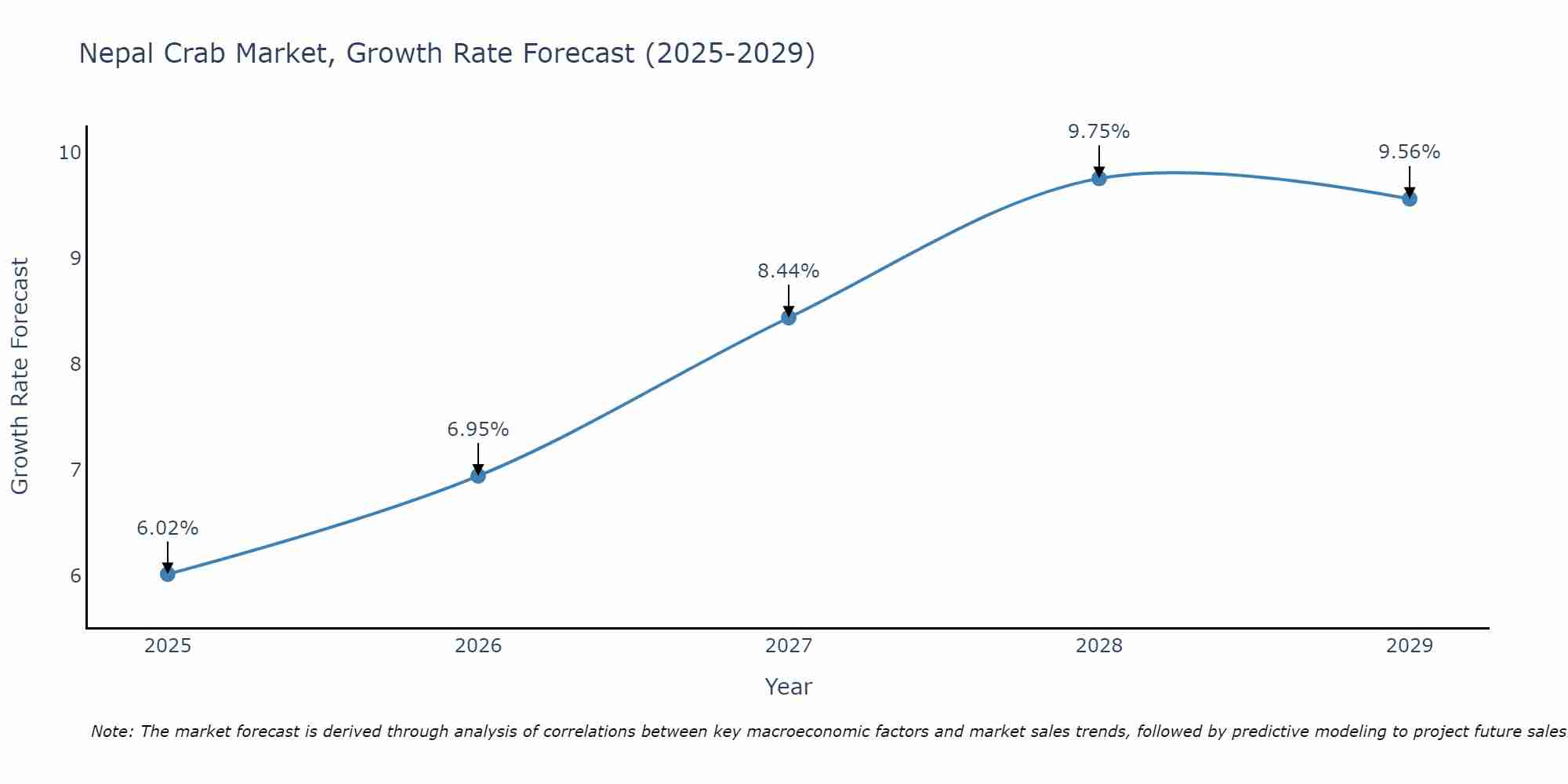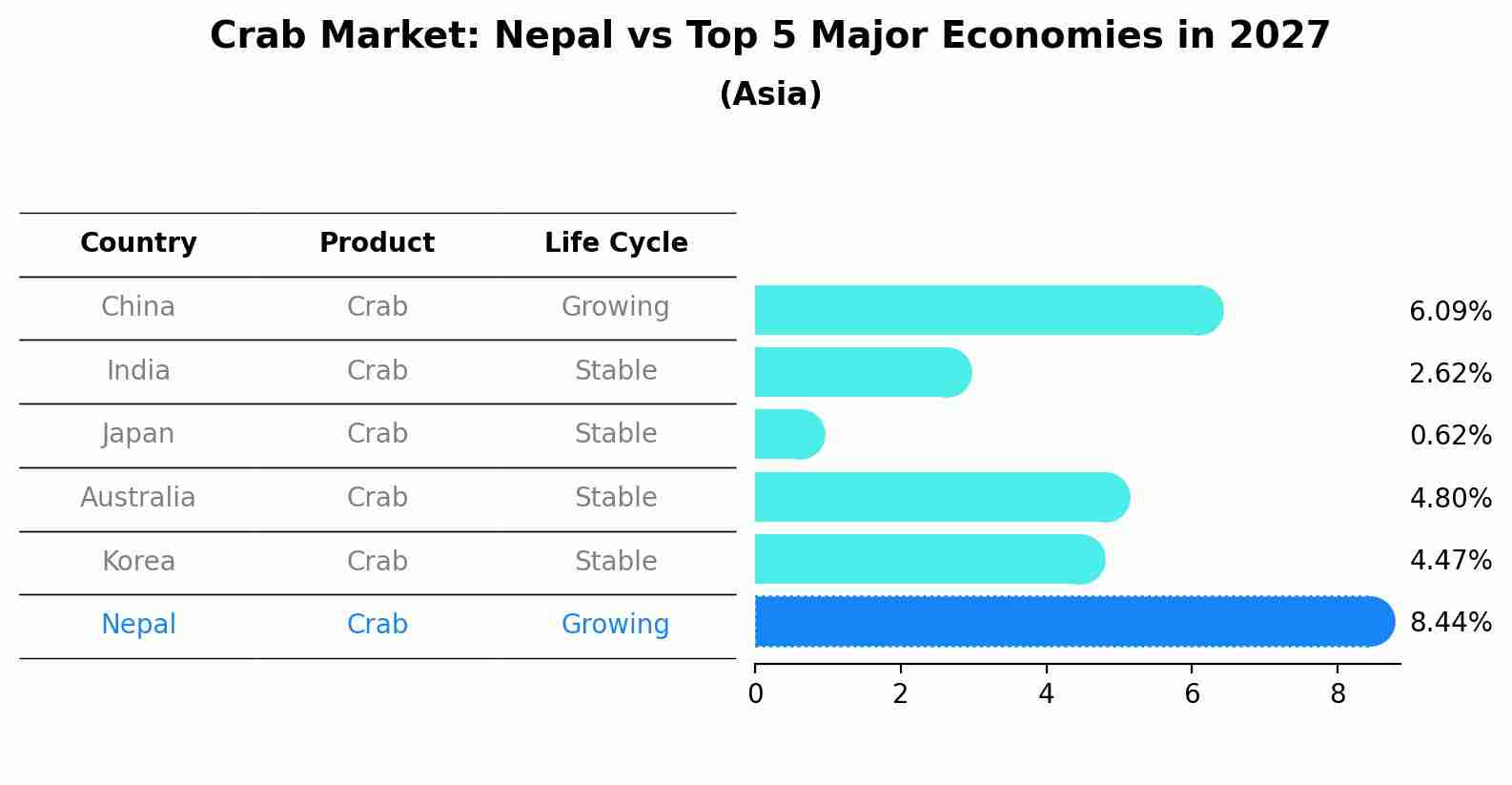Nepal Crab Market (2025-2031) Outlook | Industry, Trends, Value, Analysis, Companies, Share, Growth, Revenue, Forecast & Size
| Product Code: ETC088855 | Publication Date: Jun 2021 | Updated Date: Jun 2025 | Product Type: Report | |
| Publisher: 6Wresearch | Author: Ravi Bhandari | No. of Pages: 70 | No. of Figures: 35 | No. of Tables: 5 |
Nepal Crab Market Size Growth Rate
The Nepal Crab Market is projected to witness mixed growth rate patterns during 2025 to 2029. The growth rate begins at 6.02% in 2025, climbs to a high of 9.75% in 2028, and moderates to 9.56% by 2029.

Crab Market: Nepal vs Top 5 Major Economies in 2027 (Asia)
By 2027, Nepal's Crab market is forecasted to achieve a growing growth rate of 8.44%, with China leading the Asia region, followed by India, Japan, Australia and South Korea.

Nepal Crab Market Overview
The Nepal crab market is a niche industry predominantly focused on providing high-quality seafood to local restaurants and hotels. The market primarily sources crabs from freshwater bodies such as lakes and rivers, with a growing demand for both live and processed crab products. Due to the landlocked nature of Nepal, the availability of crabs is limited, leading to higher prices compared to coastal regions. The market is influenced by seasonal variations in crab availability, with peak seasons typically during the monsoon period. Local vendors play a crucial role in distributing crabs to various food establishments, ensuring a steady supply of fresh seafood to meet consumer demand. Overall, the Nepal crab market represents a unique sector within the seafood industry, offering opportunities for growth and development in meeting the evolving tastes of consumers.
Nepal Crab Market Trends
The Nepal Crab Market is experiencing a growing demand for live crabs, driven by an increasing interest in seafood consumption and dining out. Consumers are seeking fresh and high-quality crabs for their culinary experiences, leading to a preference for live crabs over frozen options. Additionally, there is a rising awareness of the health benefits of consuming crab meat, which is rich in protein and low in fat. As a result, restaurants and seafood retailers are focusing on sourcing live crabs directly from suppliers to meet the demand for fresh and sustainable seafood options. The market is also seeing a trend towards innovative crab dishes and unique preparations, catering to the evolving tastes of consumers looking for new and exciting culinary experiences.
Nepal Crab Market Challenges
In the Nepal Crab Market, some of the key challenges faced include issues related to transportation and logistics, as crabs are often sourced from remote areas and need to be transported to urban markets while maintaining their freshness. Additionally, there may be inconsistent supply due to factors such as seasonal variations and weather conditions, which can impact the availability of crabs in the market. Furthermore, there may be concerns about the sustainability of crab harvesting practices and the need for regulations to prevent overfishing and ensure the long-term viability of the industry. Market competition and pricing fluctuations are also significant challenges for stakeholders in the Nepal Crab Market, requiring careful navigation and strategic decision-making to remain competitive while meeting consumer demand.
Nepal Crab Market Investment Opportunities
The Nepal Crab Market presents promising investment opportunities for those looking to capitalize on the growing demand for seafood. With a rich coastal ecosystem, Nepal offers a potential source of high-quality crabs that can cater to both domestic consumption and export markets. Investing in crab farming operations, processing facilities, or export ventures could yield significant returns as the market continues to expand. Additionally, there is potential for value-added products such as crab meat, crab cakes, and canned crab products to diversify offerings and capture a broader consumer base. However, it is essential to conduct thorough market research, assess regulatory requirements, and ensure sustainable practices to maximize the long-term success and profitability of investments in the Nepal Crab Market.
Nepal Crab Market Government Policy
Government policies related to the Nepal Crab Market focus on regulating fishing practices to ensure sustainability and prevent overfishing. The government has implemented measures such as setting catch limits, establishing no-fishing zones during breeding seasons, and monitoring compliance with these regulations through regular inspections. Additionally, the government has introduced initiatives to support local crab farmers and promote the development of sustainable aquaculture practices. These policies aim to balance the economic benefits of the crab market with the need to protect the environment and preserve crab populations for future generations.
Nepal Crab Market Future Outlook
The future outlook for the Nepal crab market appears promising due to increasing demand for seafood products both domestically and internationally. The growing awareness of the health benefits associated with consuming crabs, along with the rising popularity of seafood dishes, is expected to drive market growth. Additionally, advancements in technology and aquaculture practices are likely to improve the efficiency of crab farming in Nepal, leading to higher production levels and potentially lower prices for consumers. However, challenges such as environmental sustainability, competition from other seafood products, and fluctuations in global seafood trade could impact the market in the future. Overall, with proper strategic planning and adaptation to market trends, the Nepal crab market is poised for steady growth in the coming years.
Key Highlights of the Report:
- Nepal Crab Market Outlook
- Market Size of Nepal Crab Market, 2021
- Forecast of Nepal Crab Market, 2031
- Historical Data and Forecast of Nepal Crab Revenues & Volume for the Period 2021 - 2031
- Nepal Crab Market Trend Evolution
- Nepal Crab Market Drivers and Challenges
- Nepal Crab Price Trends
- Nepal Crab Porter's Five Forces
- Nepal Crab Industry Life Cycle
- Historical Data and Forecast of Nepal Crab Market Revenues & Volume By Type for the Period 2021 - 2031
- Historical Data and Forecast of Nepal Crab Market Revenues & Volume By Blue Crab for the Period 2021 - 2031
- Historical Data and Forecast of Nepal Crab Market Revenues & Volume By Chinese Mitten Crab for the Period 2021 - 2031
- Historical Data and Forecast of Nepal Crab Market Revenues & Volume By Gazami Crab for the Period 2021 - 2031
- Historical Data and Forecast of Nepal Crab Market Revenues & Volume By Others for the Period 2021 - 2031
- Historical Data and Forecast of Nepal Crab Market Revenues & Volume By Form for the Period 2021 - 2031
- Historical Data and Forecast of Nepal Crab Market Revenues & Volume By Frozen for the Period 2021 - 2031
- Historical Data and Forecast of Nepal Crab Market Revenues & Volume By Canned for the Period 2021 - 2031
- Historical Data and Forecast of Nepal Crab Market Revenues & Volume By Others for the Period 2021 - 2031
- Nepal Crab Import Export Trade Statistics
- Market Opportunity Assessment By Type
- Market Opportunity Assessment By Form
- Nepal Crab Top Companies Market Share
- Nepal Crab Competitive Benchmarking By Technical and Operational Parameters
- Nepal Crab Company Profiles
- Nepal Crab Key Strategic Recommendations
Frequently Asked Questions About the Market Study (FAQs):
1 Executive Summary |
2 Introduction |
2.1 Key Highlights of the Report |
2.2 Report Description |
2.3 Market Scope & Segmentation |
2.4 Research Methodology |
2.5 Assumptions |
3 Nepal Crab Market Overview |
3.1 Nepal Country Macro Economic Indicators |
3.2 Nepal Crab Market Revenues & Volume, 2021 & 2031F |
3.3 Nepal Crab Market - Industry Life Cycle |
3.4 Nepal Crab Market - Porter's Five Forces |
3.5 Nepal Crab Market Revenues & Volume Share, By Type, 2021 & 2031F |
3.6 Nepal Crab Market Revenues & Volume Share, By Form, 2021 & 2031F |
4 Nepal Crab Market Dynamics |
4.1 Impact Analysis |
4.2 Market Drivers |
4.3 Market Restraints |
5 Nepal Crab Market Trends |
6 Nepal Crab Market, By Types |
6.1 Nepal Crab Market, By Type |
6.1.1 Overview and Analysis |
6.1.2 Nepal Crab Market Revenues & Volume, By Type, 2018 - 2027F |
6.1.3 Nepal Crab Market Revenues & Volume, By Blue Crab, 2018 - 2027F |
6.1.4 Nepal Crab Market Revenues & Volume, By Chinese Mitten Crab, 2018 - 2027F |
6.1.5 Nepal Crab Market Revenues & Volume, By Gazami Crab, 2018 - 2027F |
6.1.6 Nepal Crab Market Revenues & Volume, By Others, 2018 - 2027F |
6.2 Nepal Crab Market, By Form |
6.2.1 Overview and Analysis |
6.2.2 Nepal Crab Market Revenues & Volume, By Frozen, 2018 - 2027F |
6.2.3 Nepal Crab Market Revenues & Volume, By Canned, 2018 - 2027F |
6.2.4 Nepal Crab Market Revenues & Volume, By Others, 2018 - 2027F |
7 Nepal Crab Market Import-Export Trade Statistics |
7.1 Nepal Crab Market Export to Major Countries |
7.2 Nepal Crab Market Imports from Major Countries |
8 Nepal Crab Market Key Performance Indicators |
9 Nepal Crab Market - Opportunity Assessment |
9.1 Nepal Crab Market Opportunity Assessment, By Type, 2021 & 2031F |
9.2 Nepal Crab Market Opportunity Assessment, By Form, 2021 & 2031F |
10 Nepal Crab Market - Competitive Landscape |
10.1 Nepal Crab Market Revenue Share, By Companies, 2021 |
10.2 Nepal Crab Market Competitive Benchmarking, By Operating and Technical Parameters |
11 Company Profiles |
12 Recommendations |
13 Disclaimer |
- Single User License$ 1,995
- Department License$ 2,400
- Site License$ 3,120
- Global License$ 3,795
Search
Thought Leadership and Analyst Meet
Our Clients
Related Reports
- Afghanistan Apparel Market (2026-2032) | Growth, Outlook, Industry, Segmentation, Forecast, Size, Companies, Trends, Value, Share, Analysis & Revenue
- Canada Oil and Gas Market (2026-2032) | Share, Segmentation, Value, Industry, Trends, Forecast, Analysis, Size & Revenue, Growth, Competitive Landscape, Outlook, Companies
- Germany Breakfast Food Market (2026-2032) | Industry, Share, Growth, Size, Companies, Value, Analysis, Revenue, Trends, Forecast & Outlook
- Australia Briquette Market (2025-2031) | Growth, Size, Revenue, Forecast, Analysis, Trends, Value, Share, Industry & Companies
- Vietnam System Integrator Market (2025-2031) | Size, Companies, Analysis, Industry, Value, Forecast, Growth, Trends, Revenue & Share
- ASEAN and Thailand Brain Health Supplements Market (2025-2031) | Strategy, Consumer Insights, Analysis, Investment Trends, Opportunities, Growth, Size, Share, Industry, Revenue, Segments, Value, Segmentation, Supply, Forecast, Restraints, Outlook, Competition, Drivers, Trends, Demand, Pricing Analysis, Competitive, Strategic Insights, Companies, Challenges
- ASEAN Bearings Market (2025-2031) | Strategy, Consumer Insights, Analysis, Investment Trends, Opportunities, Growth, Size, Share, Industry, Revenue, Segments, Value, Segmentation, Supply, Forecast, Restraints, Outlook, Competition, Drivers, Trends, Demand, Pricing Analysis, Competitive, Strategic Insights, Companies, Challenges
- Europe Flooring Market (2025-2031) | Outlook, Share, Industry, Trends, Forecast, Companies, Revenue, Size, Analysis, Growth & Value
- Saudi Arabia Manlift Market (2025-2031) | Outlook, Size, Growth, Trends, Companies, Industry, Revenue, Value, Share, Forecast & Analysis
- Uganda Excavator, Crane, and Wheel Loaders Market (2025-2031) | Strategy, Consumer Insights, Analysis, Investment Trends, Opportunities, Growth, Size, Share, Industry, Revenue, Segments, Value, Segmentation, Supply, Forecast, Restraints, Outlook, Competition, Drivers, Trends, Demand, Pricing Analysis, Competitive, Strategic Insights, Companies, Challenges
Industry Events and Analyst Meet
Whitepaper
- Middle East & Africa Commercial Security Market Click here to view more.
- Middle East & Africa Fire Safety Systems & Equipment Market Click here to view more.
- GCC Drone Market Click here to view more.
- Middle East Lighting Fixture Market Click here to view more.
- GCC Physical & Perimeter Security Market Click here to view more.
6WResearch In News
- Doha a strategic location for EV manufacturing hub: IPA Qatar
- Demand for luxury TVs surging in the GCC, says Samsung
- Empowering Growth: The Thriving Journey of Bangladesh’s Cable Industry
- Demand for luxury TVs surging in the GCC, says Samsung
- Video call with a traditional healer? Once unthinkable, it’s now common in South Africa
- Intelligent Buildings To Smooth GCC’s Path To Net Zero


















